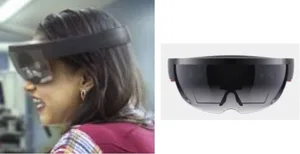Dimension NXG Pvt. Ltd. (Mumbai, India) is developing what the company claims is India’s first locally designed mixed reality headset. The product will be called the AjnaLens. The headset is pictured in the figure below.
The AjnaLens mixed reality headset.
The AjnaLens uses depth sensing 3D capture technology to interrogate the user’s environment and create a real time mesh of the surroundings. Artificial Intelligence (AI) is then used to create and accurately integrate virtual imagery into the real world environment. By this means, it becomes possible for the virtual imagery to properly interact with the contents of the real world.
It might be noted that the company literature consistently refers to the virtual imagery produced by the headset as holograms. As is so often the case, this is not correct. It is correct that AjnaLens produces high resolution stereoscopic 3D images that appears to float in the air.
Regarding the AI aspect of the AjnaLens, the company literature explains that the headset “is built using AI as its core. AjnaLens let you create, customize and grow your very own AI sidekick. You can design how your AI looks the way you want it.”
The AjnaLens offers a field of view of over 90º. The company notes that this is considerably wider than the field of view offered by current products such as the 35º provided by the HoloLens.
The company plans to improve image quality by developing highly realistic shaders. Using so-called ambient relighting technology, the intention is to improve the match between the details of the appearance of the virtual imagery and the contents of the real world, making the virtual imagery appear more realistic.
Users of the AjnaLens can control, navigate around the virtual imagery and interact with the AR objects in three different ways.
- Voice
- Gesture: Ajna’s “robust” gesture detecting system will allow the user to open apps and interact with virtual imagery by dragging, dropping and resizing them in the real world.
- Gaze: Ajna hands free, built in sensors will allow the user’s gaze to control a cursor. It should be possible for the user to select virtual images with a flick of their eyes. Users should also be able to navigate the interface just looking at user interface elements. In addition, users should be able to interact with virtual objects. As an example of such interaction, a virtual object could be resized by adjusting the edges of the object.
The AjnaLens headset is planned to have stereo speakers that will deliver a broad frequency response, rich bass and impressive volume.
There are two other points regarding the company about which they can be justifiably proud. First, the company team and the company’s technology has raised angel investment from what appears to be a wide range of premier investors. Second, the headset has already received several awards including the Graham Bell Innovation Award.
Incidentally, the company web site explains that “the name ‘Ajna’ derives from Indian Vedas. According to Indian tradition, it is the third-eye chakra. The Ajna chakra is your center of intuition, a balanced Ajna chakra invites clairvoyance, telepathy, lucid dreaming, expanding imagination and visualization.” The company claims that “Wearing our headset is like activating your Ajna chakra.”
Dimension NXG hopes to eventually attract customers from business sectors that include aerospace, automotive, defense, healthcare and manufacturing. Part of the means used to attract customers is planned to be an aggressive price for the headset. The AjnaLens is targeted to sell at about $1,500. If the company can succeed in hitting this price point, it will be significantly less than the selling price of some current competitive products. -Arthur Berman
Dimension NXG, Pankaj Raut, +91-9167469261, [email protected]

